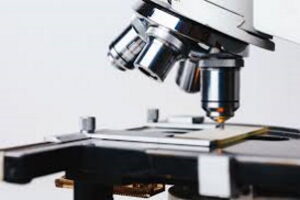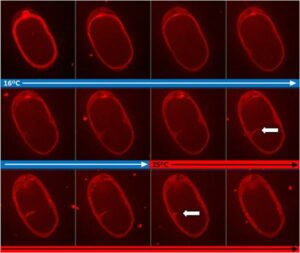Ever looked for info about the roles of actin in asymmetric cell division? Everything is reviewed here for C. elegans embryo

Ultra fast temperature shift device for in vitro experiments under microscopy
Abstract
The cell shape changes that ensure asymmetric cell divisions are crucial for correct development, as asymmetric divisions allow for the formation of different cell types and therefore different tissues. The first division of the Caenorhabditis elegans embryo has emerged as a powerful model for understanding asymmetric cell division. The dynamics of microtubules, polarity proteins, and the actin cytoskeleton are all key for this process. In this review, we highlight studies from the last five years revealing new insights about the role of actin dynamics in the first asymmetric cell division of the early C. elegans embryo. Recent results concerning the roles of actin and actin binding proteins in symmetry breaking, cortical flows, cortical integrity, and cleavage furrow formation are described.
References
- Roles of Actin in the Morphogenesis of the Early Caenorhabditis elegans Embryo (Dureen Samandar Eweis & Julie Plastino, 2020)
FAQ
Asymmetric cell divisions are a process required for correct development. They are important because they permit the formation of different cell types. These different cell types then form different tissues. The first division of the Caenorhabditis elegans embryo is used as a powerful model to understand this process. This single-cell embryo is used to investigate several related processes. These include symmetry breaking, the establishment of polarity, the assembly of microtubules, and the positioning of the spindle. The cell shape changes that happen during this type of division are also studied. The dynamics of the actin cytoskeleton, microtubules, and polarity proteins are all central to this first division.
Actin is one of the cell’s most abundant proteins. The actin cytoskeleton, along with microtubules and polarity proteins, is a key component of the first asymmetric cell division. After the embryo is fertilized, its initial symmetry is broken. This leads to a state of polarization. This polarization results in different activity of the actomyosin system. It also results in different PAR protein occupancy. The actin cytoskeleton plays many parts in the C. elegans embryo. Recent studies have provided new information regarding actin’s role in this process. Specific functions include its involvement in symmetry breaking, cortical flows, cortical integrity, and the formation of the cleavage furrow.
The actin cytoskeleton is involved in a multitude of roles within the C. elegans embryo. Its dynamics are central to the asymmetric cell division process. One of its roles relates to the process of meiosis. It is also involved in the initial breaking of symmetry that occurs after fertilization. Actin is part of the mechanism of cortical flows. It is also important for maintaining cortical integrity. A main function is the formation and positioning of the contractile ring. This ring is what leads to cytokinesis, the physical separation of the cell. Actin also has interlinks with other components, such as Aurora-A and PAR proteins.
Caenorhabditis elegans is used as a model organism. It is applied to investigations into the regulation and dynamics of actin networks. These are studied specifically within developmental processes. The first asymmetric division of the single-cell embryo is of particular interest. Researchers use this event to understand symmetry breaking. The establishment of polarity, microtubule assembly, and spindle positioning are also studied in this model. The cell shape changes that occur with asymmetric cell division are observed as well. The embryo has emerged as a powerful model for understanding this type of division. The actin cytoskeleton, microtubules, and polarity proteins are all studied within this system.




